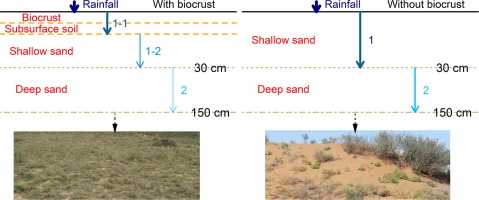当前位置:
X-MOL 学术
›
J. Hydrol.
›
论文详情
Our official English website, www.x-mol.net, welcomes your
feedback! (Note: you will need to create a separate account there.)
Ecohydrological effects of biological soil crust on the vegetation dynamics of restoration in a dryland ecosystem
Journal of Hydrology ( IF 5.9 ) Pub Date : 2018-08-01 , DOI: 10.1016/j.jhydrol.2018.06.076 Ning Chen , Xinping Wang , Yafeng Zhang , Kailiang Yu , Changming Zhao
Journal of Hydrology ( IF 5.9 ) Pub Date : 2018-08-01 , DOI: 10.1016/j.jhydrol.2018.06.076 Ning Chen , Xinping Wang , Yafeng Zhang , Kailiang Yu , Changming Zhao

|
Abstract When restoring dryland ecosystems, growing biological soil crust (biocrust) may greatly change the redistribution of rainfall in layered soils. However, ecohydrological modelling studies generally ignore biocrust and thus, the ecohydrological effects of biocrust on restorations remain largely unexplored. Using a long-term restoration case (located in the southeast edge of the Tengger Desert, northern China), we developed an ecohydrological model with explicit consideration of the infiltration in three layered soils (biocrust, shallow and deep sand layers) to investigate influences of biocrust on restoration dynamics in drylands. The proportion of infiltration that reaches ‘annual grass’ (including biocrust and shallow sand layers, 0–30 cm) and ‘shrub’ layers (30–150 cm) with biocrust significantly increased and decreased relative to the values without biocrust, respectively. Meanwhile, biocrust significantly decreased soil water content in deep sand layer, but not in shallow sand layer. As more water was used by transpiration than evaporation, the ecosystem with biocrust reached a final grass-dominated state (high grass cover of 40%, low shrub cover of 4%) rather than a shrub-dominated state (grass cover of 3%, shrub cover of 20%). This study suggests that we need to account for the roles of biocrust on rainfall infiltration to better understand vegetation and restoration dynamics in dryland ecosystems.
更新日期:2018-08-01











































 京公网安备 11010802027423号
京公网安备 11010802027423号